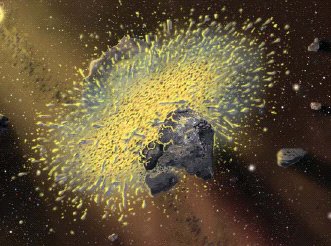A star’s belt of dust and rocks
Astronomers have obtained hints of a dusty asteroid belt around a nearby star.
By Emily Sohn
Between Mars and Jupiter, a band of rocks and dust orbits our sun. Astronomers call it the asteroid belt, and they think that it contains scraps of rock left over from a time when the planets formed nearly 5 billion years ago.
New evidence suggests that ours is not the only solar system with this type of asteroid belt. Astronomers from the University of Florida in Gainesville have found the best evidence yet that a belt of warm dust circles fairly close to a star called Zeta Leporis.
 |
|
Collisions of asteroids, as shown in this artist’s illustration, may have created the warm dust in the belt around a nearby star.
|
| J. Lomberg/Gemini Observatory |
Astronomers first became excited about Zeta Leporis in the 1980s. That’s when a satellite revealed that the star was putting out an unexpectedly large amount of infrared light. Infrared light is a type of energy. High levels of infrared radiation near a star suggest that the star is surrounded by dust. The dust absorbs visible light from the star and, in turn, emits infrared radiation, which is detectable as heat.
In 2001, researchers from the University of California, Los Angeles used the Keck Observatory on Hawaii’s Mauna Kea to show that the dust surrounding Zeta Leporis is part of a disk. They also found that the disk reaches only slightly farther from Zeta Leporis than Jupiter is from our sun.
In February 2005, the University of Florida team used the Gemini South telescope in Chile to measure the size of Zeta Leporis’ disk more accurately.
Most of the dust, they found, lies at a distance of 3 AU from the star. (One AU equals the average distance of Earth from the sun.) Our solar system’s asteroid belt stretches between 2.1 and 3.3 AU from the sun.
Scientists have already found disks of dust around other stars. But most of these disks are much larger and more distant—as far away from their stars as Pluto and the comet-filled Kuiper belt are from our sun. These bands of distant dust are also cool in temperature. The fact that the disk around Zeta Leporis is warm and fairly close to the star makes it special.
The researchers suspect that numerous asteroids continually bumped against each other near Zeta Leporis, producing a fine spray of rocky particles that became the planet’s dusty asteroid belt. It’s also possible that the dust came from a single collision between two large asteroids, which broke up both objects.
Next, the researchers want to get a better sense of the belt’s shape. If they find that the disk is circular and the dust evenly spread out, this would suggest a long, slow grinding of asteroids against each other. A more irregular shape would suggest that the dust came from a single dramatic collision, perhaps only about 100 years ago.
Whatever they find, the insight will be valuable. “For years we’ve been studying Kuiper belt–like disks,” says astronomer Charles M. Telesco of the University of Florida. “Now, we’re investigating the architecture of the inner asteroidal regions” around stars. “This is kind of new territory,” he adds.
Zeta Leporis is just 70 light-years from Earth. At 230 million years of age, the star is much younger than our 4.6-billion-year-old sun. But it’s still old enough for planets to have formed around it. The fact that Zeta Leporis has an asteroid belt similar to ours suggests that the star might also have rocky planets like Earth.—E. Sohn
Going Deeper:
Cowen, Ron. 2007. Rocky finding: Evidence of extrasolar asteroid belt. Science News 171(Jan. 6):5. Available at http://www.sciencenews.org/articles/20070106/fob5.asp.
Ramsayer, K. 2005. Chaos among the planets. Science News for Kids (June 1). Available at http://www.sciencenewsforkids.org/articles/20050601/Note2.asp .
Sohn, Emily. 2006. Saturn’s rings created by collision. Science News for Kids (April 5). Available at http://www.sciencenewsforkids.org/articles/20060405/Note3.asp .
______. 2005. Asteroid moons. Science News for Kids (Aug. 24). Available at http://www.sciencenewsforkids.org/articles/20050824/Note2.asp .
______. 2004. A dusty birthplace. Science News for Kids (Oct. 13). Available at http://www.sciencenewsforkids.org/articles/20041013/Note2.asp .







